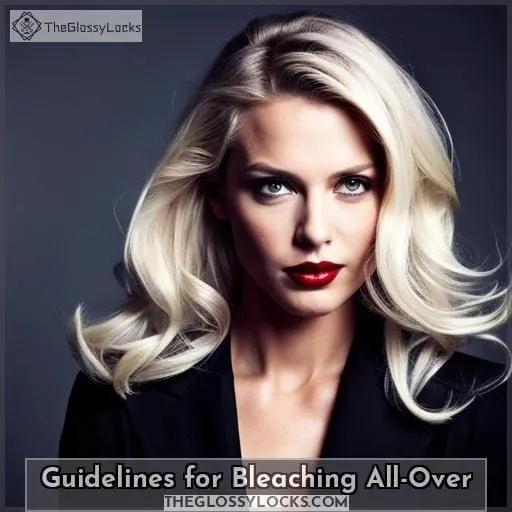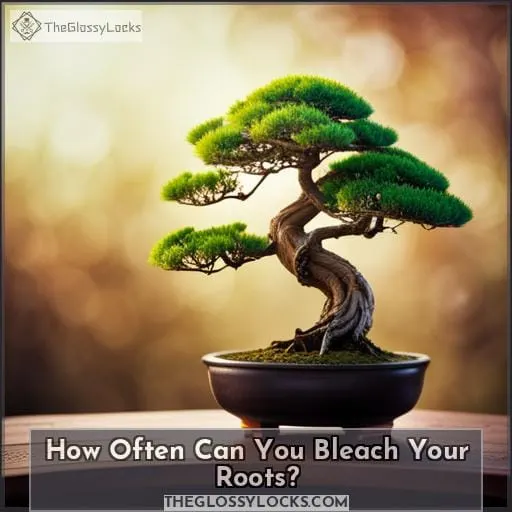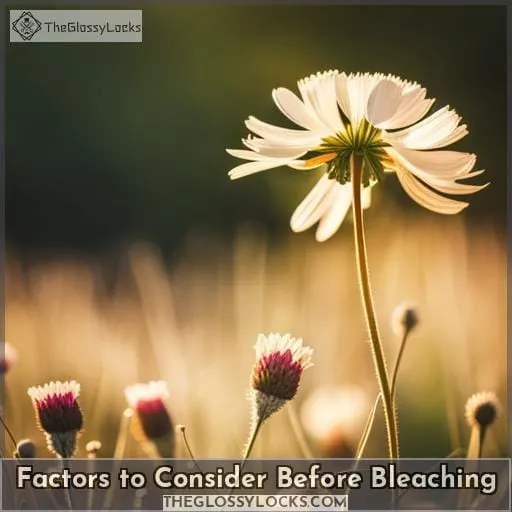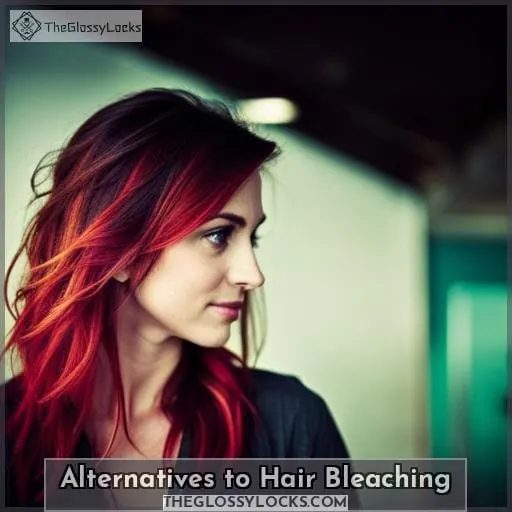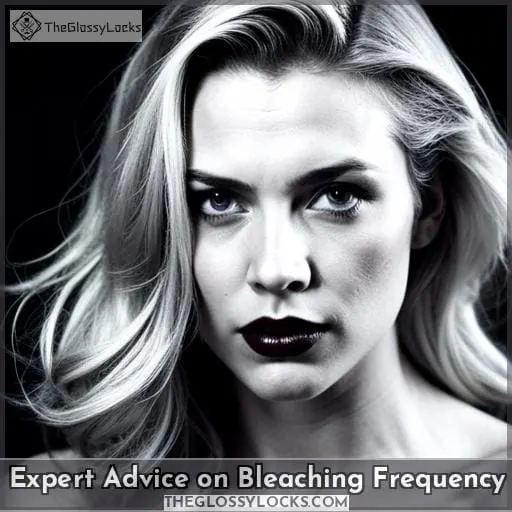This site is supported by our readers. We may earn a commission, at no cost to you, if you purchase through links.
 Are you planning to bleach your hair? Before you do, it’s essential that you understand how often you can safely bleach your hair without causing damage.
Are you planning to bleach your hair? Before you do, it’s essential that you understand how often you can safely bleach your hair without causing damage.
Bleaching is a harsh process and must be done carefully to prevent irreversible damage.
Understanding the risks involved with excessive bleaching as well as how long should pass between each session is key for maintaining healthy locks.
We’ll explore all this in our guide on how often you can bleach your hair!
Table Of Contents
Key Takeaways
- Proper bleach penetration requires time, heat, and saturation.
- Assess hair type and condition for safe bleaching frequency.
- Wait 6-8 weeks between all-over bleaching sessions.
- Root bleaching should occur every 4-6 weeks.
The Effects of Excessive Hair Bleaching
Bleaching is a chemical process that lightens hair by oxidizing pigments. It involves the use of hydrogen peroxide to open cuticles for bleach penetration and needs time and heat to work effectively. Unfortunately, over-bleaching can lead to various risks such as breakage, loss of hair strands, and brittleness in texture.
Therefore, it’s important to understand how often you should be bleaching your hair in order for it to remain healthy.
How Bleaching Works
Discovering the perfect shade of blonde for your hair requires an understanding of how bleaching works and how to keep it healthy along the way! Hydrogen peroxide in developers opens up hair cuticles, allowing bleach penetration.
If done too quickly or without saturation, patchy results can occur. It’s important to follow proper bleaching procedures and know when enough is enough—over-processing leads to dryness, frizziness, and breakage that are difficult to repair!
Understanding risks associated with over-bleaching as well as maintenance tips is key for keeping strands strong and vibrant without any damage from frequent treatments.
Risks of Over-Bleaching
Beware of the risks associated with over-bleaching: breakage, loss, and a brittle texture can be just the start. Excessive bleaching can cause gummy hair, which is difficult to manage and prone to dryness and frizz.
Understand safe practices when it comes to bleaching frequency as well as proper care for post-processing recovery periods.
To protect your overall hair health, avoid reapplying bleach before 6-8 weeks have passed. Use protein-rich shampoo, conditioner, and masks for hydration. Limit heat styling tools and opt for root touch-ups every 4-6 weeks if necessary instead of full head applications.
Guidelines for Bleaching All-Over
Ready to take the plunge and bleach your hair all-over? Before diving in, consider these guidelines.
Start by assessing how often you can safely bleach based on hair type and condition. Darker colors may require more bleaching sessions than lighter shades, so use caution when transitioning from dark to light hues.
As a general rule of thumb, wait 6-8 weeks between bleaching sessions for best results – but some experts suggest waiting even longer!
Bleached locks need special attention: choose sulfate-free shampoo and protein & moisture-rich conditioners; apply deep conditioning treatments regularly; avoid heat styling tools; use wet brushes only while brushing out knots or tangles.
Alternatives such as toning or demi-permanent color are less damaging options if minor discoloration is desired, while following proper precautions like conducting strand tests before each session help ensure safe practices during the process itself.
Don’t let any bad experiences stop you from achieving your desired look – just follow these tips for healthy hair at every step along the way!
How Often Can You Bleach Your Roots?
When considering a touch-up, be mindful that root bleaching should usually occur every 4-6 weeks, depending on the rate of hair growth. For better results and less damage to your hair, it’s important to take some precautions when you’re bleaching your roots.
Here are some tips to follow:
- Use specialized products for root touch-ups, such as color depositing shampoos and toners, instead of strong chemical bleach formulas.
- Follow proper application instructions from product labels or consult with a professional hairstylist.
- Give yourself enough waiting time between sessions so that the scalp has had plenty of time to recover before reapplying bleach or other chemicals again.
To keep up with noticeable regrowth in between full head dye jobs, do not hesitate to use temporary solutions like dry shampoo and tinted hairsprays. These are gentler alternatives compared to using regular bleach dyes frequently.
Taking these steps will help maintain healthy hair while still achieving desired looks without risking excessive damage caused by overbleaching roots too often!
Factors to Consider Before Bleaching
Before bleaching your hair, it is important to assess the condition of your hair and conduct a strand test. Additionally, having a recovery period in between bleaching sessions can help protect the health of your hair.
Knowing how often you should bleach and understanding factors such as proper aftercare are paramount for successful results without damaging effects on the texture or quality of your locks.
Assessing Hair Condition
Before bleaching your hair again, assess its condition to ensure you don’t damage it further. Check for signs of fragility like split ends or dryness, and look at the overall texture as well. Is your hair prone to breakage? Has the color become dull from previous bleaching sessions? Knowing if there are any underlying issues can help determine how often you should bleach in order to maintain healthy locks.
Alternatives such as demi-permanent color or toners may be suitable instead of full-head bleachings.
Conducting a Strand Test
Take the necessary steps to protect your hair’s health by conducting a strand test before bleaching. A strand test can help you assess the effects of bleach on your hair and determine how well it will take color.
It involves applying a small section of bleach to an isolated lock or clump, then allowing it to process for 10-15 minutes depending on desired results.
Strand tests can give you control over the outcome. They show exactly how much lift and lightening has been achieved prior to full application.
Knowing what product works best for achieving desired results is key in avoiding mistakes like patchy color or overly processed strands when coloring hair with bleach at home!
Recovery Period
Give your hair a break between bleaching sessions to give it time to bounce back – don’t push its luck! Waiting at least two weeks after each full-head bleach is essential for healthy hair. Root touch-ups can be done every 4–6 weeks, depending on the rate of growth and condition of the hair.
For maximum hydration during recovery periods, use protein-rich shampoos and conditioners or deep conditioning masks. Avoid heat styling tools as much as possible. Alternatives like toners and demi permanent color can help fix discoloration without overprocessing your locks.
It’s crucial to stick with safe guidelines when considering how often you should bleach. No more than once every 8–10 weeks overall, waiting 2+ weeks between each session, and root bleaching only if necessary.
Alternatives to Hair Bleaching
If you’re looking to change your hair color, there are several alternatives to bleaching. Using shampoo specifically designed for colored hair and toning can help maintain the desired shade without damaging it.
It’s especially important to be mindful when making drastic changes from dark colors, as best practices should be followed in order to keep the health of your locks intact.
Using Shampoo for Colored Hair
For optimal maintenance of your newly-colored hair, consider investing in shampoo and conditioner specifically formulated for colored tresses. Look for products that are sulfate-free, protein and moisture-rich to ensure hydration benefits.
Avoid harsh ingredients like parabens or silicone as they can strip away color molecules over time. When selecting a product suited to your shade, use one made specifically for platinum blonde or other desired color after bleaching.
Demi-permanent toners work well when you want to achieve subtle lightening effects without the need for bleach or dye treatments after bleaching is complete.
With proper care using these specialty shampoos and conditioners, you’ll enjoy vibrant locks while protecting the health of your hair from further damage due to excessive processing.
Toning Hair
Try toning your hair for a gentler way to lighten locks. By using toners, you can achieve subtle color changes without risking damage from bleach. To select the best option, consider factors like porosity and desired shade of color.
Toning maintenance includes weekly deep conditioning treatments with special shampoos and conditioners designed for colored hair. You can also DIY toning if done carefully, but it’s always best to consult a professional hairstylist first if trying this route after botched bleach jobs or lightening dyed hair too much.
The benefits of using toners include keeping cuticles sealed while still achieving lighter shades.
Best Practices for Dark Hair
If you have dark hair, it’s important to take extra care when lightening or toning your locks. To maintain healthy hair and vibrant color, find a stylist that you trust. Avoid heat styling before and after bleaching.
Color correction can be tricky. Follow proper procedures such as conducting strand tests, using the right type of bleach and volume, and avoiding over-processing by leaving bleach on too long. After bleaching, apply a deep conditioner to reverse damage. Be cautious with drastic changes from dark to light.
With proper maintenance techniques in place, along with patience and knowledge about safe bleaching frequency, beautiful results are achievable while protecting the health of your tresses.
Maintaining Hair Health After Bleaching
It’s important to understand that bleaching your hair too often can lead to serious damage, which is why it’s essential to know how long you should wait in between sessions. To maintain healthy hair and prevent breakage, experts recommend waiting 6-8 weeks before rebleaching and following up with hydrating treatments such as masks or hot oil treatments.
Recommended Waiting Period
Take a break between bleaching sessions and listen to your hair – waiting 6-8 weeks is recommended for healthy tresses.
To prevent damage, consider alternatives like toners or demi-permanent color instead of full head bleachings.
Be mindful when selecting products and follow instructions carefully; using the right type of bleach with appropriate volume is essential for safe practices.
Apply deep conditioner after bleaching to restore hydration, then use sulfate-free shampoo and protein-rich masks during the recovery period.
Lastly, avoid heat styling tools as they can worsen existing damage from overprocessing – take extra care when it comes to your hair health!
Hair Maintenance Tips
You can keep your bleached hair healthy by following a few easy tips. Use sulfate-free and protein-rich shampoos, conditioners, and masks to provide hydration. Allow ample recovery time between bleaching sessions – at least 6 to 8 weeks if possible.
Consider toner alternatives for minor discoloration instead of full bleach treatments.
Be sure not to overprocess or reapply bleach before the recommended intervals have passed. This can lead to breakage, loss, dryness, and frizziness, all of which could end up being more expensive in the long run due to repairs or replacements required thereafter.
Expert Advice on Bleaching Frequency
Consulting a professional and following the right bleaching frequency can be a lifesaver for your locks – after all, prevention is better than cure! Waiting 6 to 8 weeks between bleaching sessions is generally recommended.
However, some experts suggest waiting even longer intervals depending on hair type and condition.
If opting for root touch-ups every 4-6 weeks or so, it’s essential to use specialized shampoo for colored hair to maintain color as well as deep conditioning treatments afterwards. Alternatives such as toners or demi-permanent color may also help correct discoloration issues without damaging effects of bleaching too often.
When in doubt, ask your stylist about their recommendations regarding recovery period length and other potential solutions prior making any decisions that could harm your hair health down the road.
Conclusion
In a nutshell, bleaching your hair can be a great way to achieve a desired look, but it’s important to do it safely. Repeated bleaching can quickly lead to damage, breakage, and dryness. It’s recommended to wait 6-8 weeks between sessions to allow the hair to recover, and even longer if your hair is already damaged.
Additionally, use specialized shampoo, conditioner, and masks to nourish your hair, and avoid reapplying bleach before the recommended time frame. Pay attention to your hair’s condition and take the necessary precautions to ensure healthy hair while achieving the look you want.
With the right care and understanding of how often to bleach your hair, you can enjoy beautiful results without sacrificing the health of your locks.


